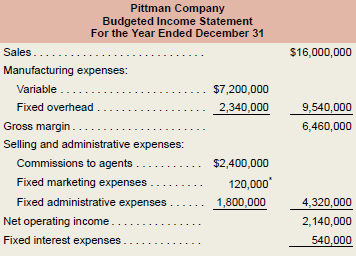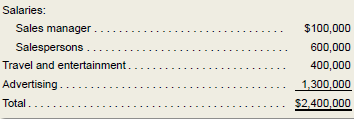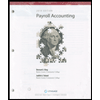
Concept explainers
Pittman Company is a small but growing manufacturer of telecommunications equipment. The company has no sales force of itsown; rather, it relies completely on independent sales agents to market its products. These agents are paid a sales commission of15% for all items sold.
Barbara Cheney, Pittman’s controller, just prepared the company’s


As Barbara handed the statement to Karl Vecci, Pittman’s president, she commented, “I went ahead and used the agents’ 15%commission rate in completing these statements, but we’ve just learned that they refuse to handle our products next year unless we increase the commission rate to 20%.”
“That’s the last straw,” Karl replied angrily. “Those agents have been demanding more and more, and this time they’ve gone too far. How can they possibly defend a 20% commission rate?”
“They claim that after paying for advertising, travel, and the other costs of promotion, there’s nothing left over for profit,” replied Barbara.
“I say it’s just plain robbery,” retorted Karl. “And I also say it’s time we dumped those guys and got our own sales force. Can you get your people to work up some cost figures for us to look at?”
“We’ve already worked them up,” said Barbara. “Several companies we know about pay a 7.5% commission to their own sales people, along with a small salary. Of course, we would have to handle all promotion costs, too. We figure our fixed expenses would increase by $2,400,000 per year, but that would be more than offset by the $3,200,000 (20% Ă— $16,000,000) that we would avoid on agents’ commissions.”
The breakdown of the $2,400,000 cost follows:

“Super,” replied Karl. “And I noticed that the $2,400,000 equals what we’re paying the agents under the old 15% commission rate.”
“It’s even better than that,” explained Barbara. “We can actually save $75,000 a year because that’s what we’re paying our auditors to check out the agents’ reports. So our overall administrative expenses would be less.”
“Pull all of these numbers together and we’ll show them to the executive committee tomorrow,” said Karl. “With the approval of the committee, we can move on the matter immediately.”
Required:
- Compute Pittman Company’s break-even point in dollar sales for next year assuming:
- The agents’ commission rate remains unchanged at 15%.
- The agents’ commission rate is increased to 20%.
- The company employs its own sales force.
- Assume Pittman Company decides to continue selling through agents and pays the 20% commission rate. Determine the dollar sales required to generate the same net income as contained in the budgeted income statement for next year.
- Determine the dollar sales at which net income would be equal regardless of whether Pittman Company sells through agents (at a20% commission rate) or employs its own sales force.
- Compute the degree of operating leverage the company would expect to have at the end of next year assuming:
- The agents’ commission rate remains unchanged at 15%.
- The agents’ commission rate is increased to 20%.
- The company employs its own sales force.
- Based on the data in (1) through (4) above, make a recommendation as to whether the company should continue to use sales agents (at a 20% commission rate) or employ its own sales force. Give reasons for your answer.
Use income before income taxes in your operating leverage computation.
Want to see the full answer?
Check out a sample textbook solution
Chapter 2 Solutions
CONNECT ONLINE ACCESS F/MANAGERIAL ACC.
- Which is not an objective of internal controls?A. Safeguard assetsB. Improve profitsC. Ensure accurate recordsD. Promote operational efficiency no aiarrow_forwardPlease provide the accurate answer to this financial accounting problem using appropriate methods.arrow_forwardI am searching for the accurate solution to this financial accounting problem with the right approach.arrow_forward
- 20 Nelson and Murdock, a law firm, sells $8,000,000 of four-year, 8% bonds priced to yield 6.6%. The bonds are dated January 1, 2026, but due to some regulatory hurdles are not issued until March 1, 2026. Interest is payable on January 1 and July 1 each year. The bonds sell for $8,388,175 plus accrued interest. In mid-June, Nelson and Murdock earns an unusually large fee of $11,000,000 for one of its cases. They use part of the proceeds to buy back the bonds in the open market on July 1, 2026 after the interest payment has been made. Nelson and Murdock pays a total of $8,456,234 to reacquire the bonds and retires them. Required1. The issuance of the bonds—assume that Nelson and Murdock has adopted a policy of crediting interest expense for the accrued interest on the date of sale.2. Payment of interest and related amortization on July 1, 2026.3. Reacquisition and retirement of the bonds.arrow_forward13 Which of the following is correct about the difference between basic earnings per share (EPS) and diluted earnings per share? Question 13 options: Basic EPS uses comprehensive income in its calculation, whereas diluted EPS does not. Basic EPS is not a required disclosure, whereas diluted EPS is required disclosure. Basic EPS uses total common shares outstanding, whereas diluted EPS uses the weighted-average number of common shares. Basic EPS is not adjusted for the potential dilutive effects of complex financial structures, whereas diluted EPS is adjusted.arrow_forwardPlease explain the solution to this general accounting problem with accurate explanations.arrow_forward
- I need guidance with this financial accounting problem using the right financial principles.arrow_forwardGeneral Accounting Question Solutionarrow_forwardWhich is not an objective of internal controls?A. Safeguard assetsB. Improve profitsC. Ensure accurate recordsD. Promote operational efficiencyarrow_forward

 Cornerstones of Cost Management (Cornerstones Ser...AccountingISBN:9781305970663Author:Don R. Hansen, Maryanne M. MowenPublisher:Cengage Learning
Cornerstones of Cost Management (Cornerstones Ser...AccountingISBN:9781305970663Author:Don R. Hansen, Maryanne M. MowenPublisher:Cengage Learning

